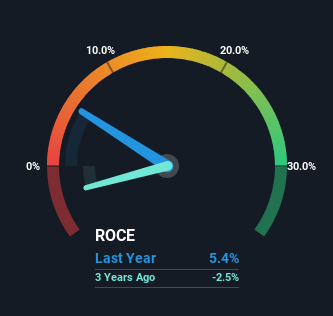
What trends should we look for it we want to identify stocks that can multiply in value over the long term? Ideally, a business will show two trends; firstly a growing return on capital employed (ROCE) and secondly, an increasing amount of capital employed. Ultimately, this demonstrates that it's a business that is reinvesting profits at increasing rates of return. However, after investigating Shenzhen Quanxinhao (SZSE:000007), we don't think it's current trends fit the mold of a multi-bagger.
Understanding Return On Capital Employed (ROCE)
If you haven't worked with ROCE before, it measures the 'return' (pre-tax profit) a company generates from capital employed in its business. The formula for this calculation on Shenzhen Quanxinhao is:
Return on Capital Employed = Earnings Before Interest and Tax (EBIT) ÷ (Total Assets - Current Liabilities)
0.054 = CN¥13m ÷ (CN¥367m - CN¥123m) (Based on the trailing twelve months to September 2023).
Thus, Shenzhen Quanxinhao has an ROCE of 5.4%. In absolute terms, that's a low return and it also under-performs the Hospitality industry average of 8.4%.
Check out our latest analysis for Shenzhen Quanxinhao

While the past is not representative of the future, it can be helpful to know how a company has performed historically, which is why we have this chart above. If you'd like to look at how Shenzhen Quanxinhao has performed in the past in other metrics, you can view this free graph of Shenzhen Quanxinhao's past earnings, revenue and cash flow.
The Trend Of ROCE
Over the past five years, Shenzhen Quanxinhao's ROCE has remained relatively flat while the business is using 36% less capital than before. When a company effectively decreases its assets base, it's not usually a sign to be optimistic on that company. In addition to that, since the ROCE doesn't scream "quality" at 5.4%, it's hard to get excited about these developments.
On another note, while the change in ROCE trend might not scream for attention, it's interesting that the current liabilities have actually gone up over the last five years. This is intriguing because if current liabilities hadn't increased to 34% of total assets, this reported ROCE would probably be less than5.4% because total capital employed would be higher.The 5.4% ROCE could be even lower if current liabilities weren't 34% of total assets, because the the formula would show a larger base of total capital employed. With that in mind, just be wary if this ratio increases in the future, because if it gets particularly high, this brings with it some new elements of risk.
The Bottom Line
In summary, Shenzhen Quanxinhao isn't reinvesting funds back into the business and returns aren't growing. And investors appear hesitant that the trends will pick up because the stock has fallen 44% in the last five years. In any case, the stock doesn't have these traits of a multi-bagger discussed above, so if that's what you're looking for, we think you'd have more luck elsewhere.
If you'd like to know about the risks facing Shenzhen Quanxinhao, we've discovered 2 warning signs that you should be aware of.
If you want to search for solid companies with great earnings, check out this free list of companies with good balance sheets and impressive returns on equity.
New: Manage All Your Stock Portfolios in One Place
We've created the ultimate portfolio companion for stock investors, and it's free.
• Connect an unlimited number of Portfolios and see your total in one currency
• Be alerted to new Warning Signs or Risks via email or mobile
• Track the Fair Value of your stocks
Have feedback on this article? Concerned about the content? Get in touch with us directly. Alternatively, email editorial-team (at) simplywallst.com.
This article by Simply Wall St is general in nature. We provide commentary based on historical data and analyst forecasts only using an unbiased methodology and our articles are not intended to be financial advice. It does not constitute a recommendation to buy or sell any stock, and does not take account of your objectives, or your financial situation. We aim to bring you long-term focused analysis driven by fundamental data. Note that our analysis may not factor in the latest price-sensitive company announcements or qualitative material. Simply Wall St has no position in any stocks mentioned.
About SZSE:000007
Shenzhen Quanxinhao
Engages in property leasing and management business in China and internationally.
Excellent balance sheet with proven track record.
Market Insights
Community Narratives


